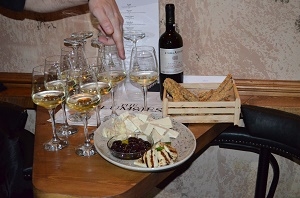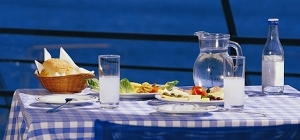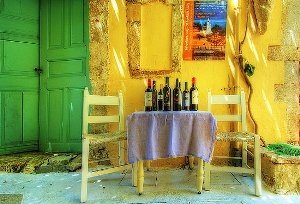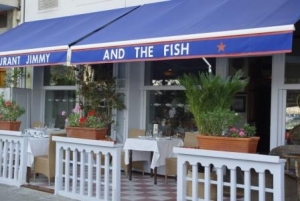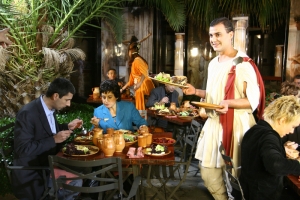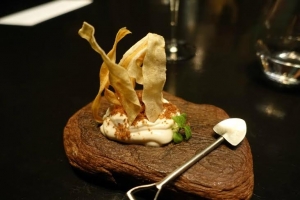Ever since Funky Gourmet - Athens’ high temple to molecular cuisine - won its second Michelin Star last year, my husband and I had been itching to go and find out what all the fanfare was about.
Having trained at the legendary “El Bulli” in Spain (the tiny restaurant famed for producing the planet’s most audacious “haute cuisine”), we guessed that Funky Gourmet’s founding chefs Georgianna Hiliadeki and Nikos Roussos must know their way pretty well around a kitchen (and a science lab or two!)
But sadly, with one of the scariest waiting lists in town, we’d been confined to drooling over friends’ glowing Facebook and Instagram posts. Until last weekend. When we finally joined the exalted few lucky enough to snare a prime table for two on a Friday night.
So, does Funky Gourmet live up to its hype?
A resounding yes. And for reasons that are not just about the food (which we’ll get to soon, we promise!). Like any much-loved recipe, there isn’t just one winning ingredient that contributes to the success of the Funky Gourmet Experience.
The sense of adventure starts before you even walk in the door. The restaurant is located in a gritty pocket of Keramikos, well off the main tourist drag, where the neighboring buildings look so uncherished, you fear you must be in the wrong place. Until you spot the lone neo-classical beauty that has been exquisitely restored on the corner (there’s no sign to give the game away) and are ushered inside by a friendly Funky Gourmet greeter.
Inside, the actual dining space upstairs is fairly compact, lending a clubby and inviting ambience that’s offset nicely by the striking avant-garde décor and bold, sensual artwork (a hint of flavors to come!). We were dining unfashionably early for most Greeks. When we sat down at 9pm, the restaurant was mostly empty; by 11pm, it was heaving. But by being early birds, we got the best seat in the house, right against the picture window, with a once-majestic moonlit mansion serving as our romantic backdrop.
My husband and I decided to totally surrender ourselves to the Funky Gourmet Odyssey by opting for one of their Degustation Menus where each course is thoughtfully matched with a different wine (which was included in the price).
We went for Menu Number 2 (at a price of €100 a head - or €150 when paired with wine). Fifteen micro-courses of what one might loosely classify: “Molecular gastronomy with a Mediterranean twist.” (Or Taverna-on-acid, as one reviewer put it!)
Enough friends had prepared us so that we knew what to expect. A procession of dainty bite-sized morsels, each one prettier (or more surreal) than the last – and most no bigger than a golf-ball! Food as intellectual art with a sense of humor on the side. And all served up to you with flourish and theatricality by the restaurant’s super-hospitable and well-trained waiting staff.
Happily, you don’t need to pack a muesli bar in your handbag just in case you’re still hungry afterwards. Even my strapping husband declared himself “simply stuffed” by the time the first of the two dessert courses (chocolate soup!) arrived.
So what were the highlights?
For me, the pastitsio appetizer, which came as the last in a series of 4 starters, was the star of the show with its dreamy creamy flavour combinations that left you wanting more. So much more. (Especially when accompanied with a dazzling Tselepos Estate Brut Sparkling wine.)
I also loved the fun and lightness of the “Kakavia Fish Soup” course where you got to poach delicate raw furls of Shabu fish yourself in the warm broth before eating.
And while it doesn’t look as “purdy” as some of the other dishes, I am still days later marveling about the Greek salad course where they miraculously infuse all the main flavours of a “horiatiki” into an innocuous-looking ball of intense-tasting white sorbet (the cucumber absolutely pops!)
My husband, on the other hand, adored the earthy richness of the snails, served sautéed in a baby cassoulet, surrounded by fragrant lentils and garnished with wild greens.
His other favourite was the two-part Silence of the Lambs course: (Act One being a boldly-seasoned portion of lamb’s brain served on a tiny pitta in a nod to Greece’s most popular street food; and Act Two, a refreshingly rustic rack of lamb trio that comes at just the right moment in the taste parade.)
The crowd pleaser of the evening was the dessert finale, the Orange Explosion. It comes to your table as two small gold-wrapped balls on a bed of exotic leaves partially obscured by dramatic swirls of liquid nitrogen (like something out of an Indiana Jones banquet). When the “smoke clears” and you bite into the delicate chocolate sphere, a geyser of chilled orange juice explodes in your mouth. Lots of fun.
No, it’s not a cheap night out. But this kind of clever-crazy cuisine is not something you could indulge in every day, even if you wanted to. Funky Gourmet is an Event. A magical mystery tour that’s provocative, playful and unconventional – and with unerringly fantastic service that left us both feeling pampered and valued.
The menu we chose was not without its flaws. There were some weaker links in the chain; a couple of plates that to me, were overly-salted. Or just too successively rich for my palette. But it seems churlish to name names when everything else at this restaurant is done with such grace and class. And most of all, joyousness.
I think my husband put it best, when still in the grip of a full-scale food swoon in the taxi home afterwards, he declared. “Wow! It’s funky. AND gourmet!”
As for me, I’ll never look at a Greek salad the same way again!
Funky Gourmet, 13 Paramythias St and Salaminos, Keramikos, 10435.
Visit: www.funkygourmet.com
To read more daily buzz about Athens and Greece, visit G&I Custom Luxury Travel on Facebook (where this review first appeared) - and please take a moment to LIKE our page!
Review by Amanda Dardanis

